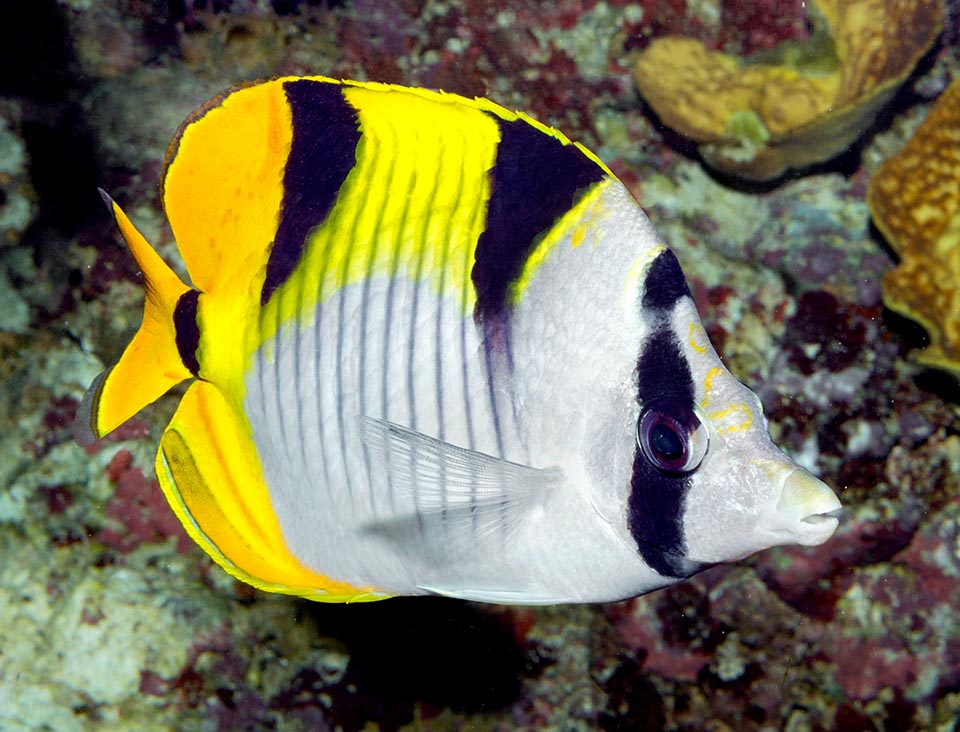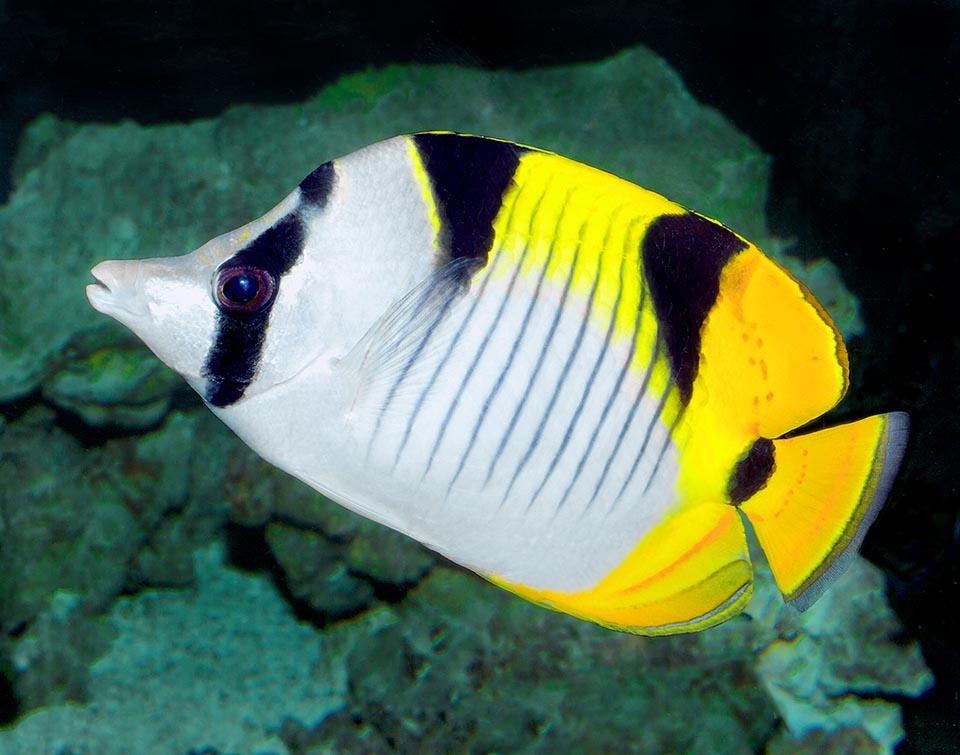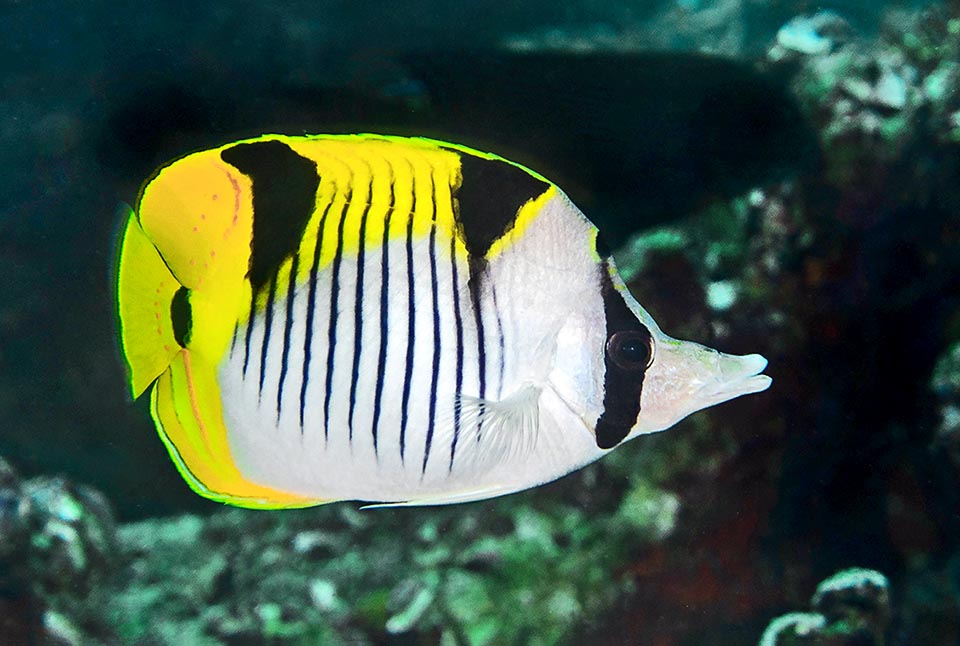Family : Chaetodontidae

Text © Giuseppe Mazza

English translation by Mario Beltramini

The Blackwedged butterflyfish (Chaetodon falcula) is characterized by black dorsal drawings evoking the shape of a saddle or of a sickle as its scientific name states © Giuseppe Mazza
The beautiful and strange Blackwedged butterflyfish (Chaetodon falcula Bloch, 1795), belongs to the class of Actinopterygii, the ray-finned fishes, to the order of Perciformes and to the colorful and well known family of Chaetodontidae.
The name of the genus Chaetodon comes from the Greek “χαίτη” (khaite) = hair and “ὀδούς” (odous) = tooth, due to the “bristle-shaped teeth”. The name of the species falcula means in Latin “sickle”, with reference to the pointed dorsal spots having the profile of a small scythe.
The Italian name (Pesce farfalla a doppia sella = double saddled butterflyfish) interprets them, on the contrary, as two saddles, instead of Saddle butterflyfish (Chaetodon ephippium ), which has only one saddle, bigger and of a more likely shape.
Zoogeography
It is mainly present in the Indian Ocean and, in a small part, in the Pacific. We find it in South Africa, East Africa, Madagascar, the Seychelles, Chagos Archipelago, Maldives, Sri Lanka, India, the Andaman Islands, Thailand, Indonesia and then in Vietnam and in Taiwan.

Present in the Indian Ocean tropical waters and in small part of the Pacific, it eats polyps of madrepores and other coelenterates, crustaceans, mollusks and algae © Giuseppe Mazza
Ecology-Habitat
It lives in the coral formations in relatively shallow waters up to 15 m of depth.
Morpho-physiology
The blackwedged butterflyfish can reach the 20 cm, even if usually it is smaller. The body is flat, more or less oval, with snout elongated and robust for looking for food among the corals.
The dorsal fin has 12-13 spiny rays and 23-25 soft; the anal has 3 spiny rays and 20-21 soft; the ventral and the pectoral ones are unarmed; the caudal is more or less blunt.
It reminds, in the pattern with vertical stripes on white background and the black band crossing the eye, the livery of the Chaetodon lineolatus. Also here, the back has yellow hues, but this colour extends to the whole back, crossed by the two typical black sickles.

The elongated snout allows rummaging in the ravines and, considering the good resilience and its very varied diet, nowadays it is not an endangered species © Rafi Amar
It shows a certain resemblance also to the Chaetodon ulietensis which also has elongated snout, the black ocular band and the vertical striped on white background, the yellow back and the black spot on the caudal peduncle, but the two sickles are decidedly longer and squared, especially the first one, which, among other things, is paler.
Ethology-Reproductive Biology
The blackwedged butterflyfish has a mixed alimentation: it nourishes of polyps of madrepores and other coelenterates, but also of crustaceans, molluscs and seaweeds. It is often found paired or in small schools which may count even a score of individuals.
The eggs are pelagic and the juveniles resemble a lot to the adults, apart the snout, shorter, and the black bands proportionally more extended. The populations may double in less than 15 months and, excluding the aquaria trade, it is not a species chased by the man or haunted by the environmental changes. The fishing vulnerability index is very low: only 10 on a scale of 100.
Synonyms
Anisochaetodon falcula Bloch, 1795; Chaetodon dizoster Valenciennes, 1831; Tetragonoptrus dizoster Valenciennes, 1831.
→ For general information about FISH please click here.
→ For general information about BONY FISH please click here
→ For general information about CARTILAGINOUS FISH please click here.
→ To appreciate the BIODIVERSITY of BONY FISH please click here.
→ To appreciate the BIODIVERSITY of CARTILAGINOUS FISH please click here.
